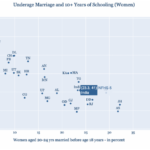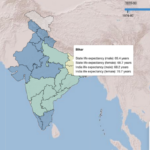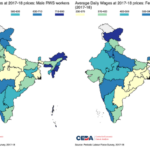GenderStats 5: Underage Marriage -1
On December 21, 2021, the Government of India introduced the Prohibition of Child Marriage (Amendment) Bill, 2021 in the Lok Sabha. The bill seeks to raise the minimum legal age to marry for women from 18 to 21. The bill was sent to a Parliamentary Standing Committee for further deliberation.
The move to raise the legal age to marry for women has led to a debate on the need and effectiveness for such a fix. The Prohibition of Child Marriage Act (2006) defines a child as a male under 21 years of age, and a female under 18 years of age. It provides for two years imprisonment for an adult marrying a child and for solemnizing a child marriage.
In this graph, we look at the state-wise percentage of women (aged 20-24) who were married before they turned 18 years old, as per NFHS-3, NFHS-4, and NFHS-5. Select the round of NFHS using the slider in the top right corner and then hover over the state to find the percentage of 20–24-year-old women who were married before 18 years of age.
In NFHS-3 (2005-06), nearly half (47.4 percent) of all Indian women aged 20-24 years were married before they turned 18. The highest percentage of underage marriage was seen in Bihar at 69 percent followed by Rajasthan at 65.2 percent and Jharkhand at 63.2 percent. The lowest percentage of 20-24-year-old women marrying before they turned 18 was seen in Goa at 12.1 percent followed by Himachal Pradesh at 12.3 percent.
Over the next decade, India saw a sharp decline in women marrying before turning 18. In NFHS-4 (2015-16), the national average for 20-24-year-old women married before turning 18 came down to 26.8 percent. Among states, the highest percentage was once again seen in Bihar at 42.5 percent (down from 69 percent in NFHS-3), followed by West Bengal at 41.6 percent, and Jharkhand at 37.9 percent. Among states, the lowest percentage was seen in Kerala, and Punjab at 7.6 percent followed by Himachal Pradesh at 7.9 percent.
The fifth round of NFHS (2020-21) saw the percentage of women marrying before turning 18 decline further. For India, this percentage (women aged 20-24 married before turning 18) came down to 23.3 percent in NFHS-5. The highest percentage was seen in West Bengal at 41.6 percent (unchanged from NFHS-4), followed by Bihar at 40.8 percent, and Tripura at 40.1 percent. Among states, the lowest percentage was seen in Himachal Pradesh at 5.4 percent, followed by Nagaland at 5.6 percent, and Goa at 5.8 percent.
Thus, data shows that between 2005-06 and 2020-21, the percentage of 20-24-year-old women who were married before turning 18 was halved from 47.4 percent in NFHS-3 to 23.3 percent in NFHS-5. Thus, the existing legal regime and economic changes had already reduced the incidence of underage marriage in the country substantially.
“GenderStats by CEDA” is a new series by the Centre for Economic Data and Analysis on the Picture This page. With the help of graphs, we will highlight the socio-economic and health status of Indian women and help understand their position vis-à-vis Indian men and other women in the rest of the world. If you have a suggestion for us or if there is an indicator that you would like us to focus on, please write to us at ceda@ashoka.edu.in
If you wish to republish this article or use an extract or chart, please read CEDA’s republishing guidelines.







